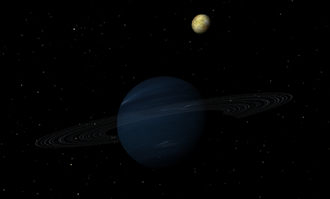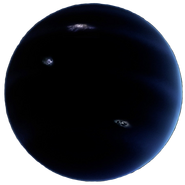mNo edit summary Tag: Visual edit |
No edit summary Tag: Visual edit |
||
| Line 1: | Line 1: | ||
| − | {{Planet|image = [[File:planet-9-and-a-moon.png|330px]]|caption = What Planet 9 would hypothetically look like, depicted here as a dark, Neptune-like with a moon|discover = |date = Claimed|Name = Planet 9|planet = Planet 9|satellite = Probably many|distance = Semi-major axis 500.0 (AU)|diameter = 39000|orbit = Orbital period 11180.34 (years), Semi-major axis 500.0 (AU), Eccentricity 0.25, Inclination 20.0 (degrees), Ascending node 90.0, Argument of pericenter 140.0 (degrees)|mass = 10 Earth mass|position = Mean anomaly 104.0}}[[File:Planet nine-etnos now-new2.png|thumb|681x681px|The orbit of 2015 KG<sub>163</sub> (right side, in orange) and other extreme detached objects, along with the hypothetical Planet Nine's orbit on the right]] |
+ | {{Planet|image = [[File:planet-9-and-a-moon.png|330px]]|caption = What Planet 9 would hypothetically look like, depicted here as a dark, Neptune-like with a moon|discover = |date = Claimed|Name = Planet 9|planet = Planet 9|satellite = Probably many|distance = Semi-major axis 500.0 (AU)|diameter = 39000|orbit = Orbital period 11180.34 (years), Semi-major axis 500.0 (AU), Eccentricity 0.25, Inclination 20.0 (degrees), Ascending node 90.0, Argument of pericenter 140.0 (degrees)|mass = 10 Earth mass|position = Mean anomaly 104.0}}[[File:Planet nine-etnos now-new2.png|thumb|681x681px|The orbit of 2015 KG<sub>163</sub> (right side, in orange) and other extreme detached objects, along with the hypothetical Planet Nine's orbit on the right]]<gallery> |
| ⚫ | |||
9 Transparent.png |
9 Transparent.png |
||
| ⚫ | |||
| ⚫ | |||
| + | |||
| ⚫ | |||
| + | |||
| + | (Note: It looks like [[Neptune]], only its darker)[[Category:Gas Giants]] |
||
[[Category:Hypothetical Bodies]] |
[[Category:Hypothetical Bodies]] |
||
[[Category:Planets]] |
[[Category:Planets]] |
||
Revision as of 17:42, 6 November 2020

The orbit of 2015 KG163 (right side, in orange) and other extreme detached objects, along with the hypothetical Planet Nine's orbit on the right
Planet X
is a hypothetical planet in the outer Solar System. Its gravitational influence could explain the abnormal orbits of a group of trans-Neptunian objects (TNOs) found mostly beyond the Kuiper belt. It has a diameter of 35000 to 52000 kilometers.
(Note: It looks like Neptune, only its darker)

